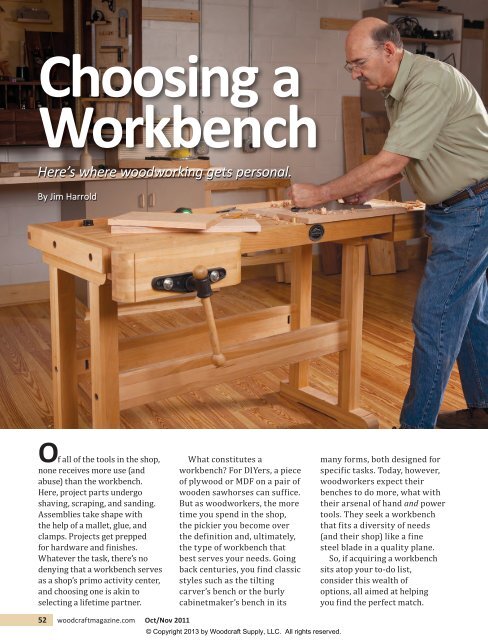43-Choosing a Bench-2.indd - Woodcraft Magazine
43-Choosing a Bench-2.indd - Woodcraft Magazine
43-Choosing a Bench-2.indd - Woodcraft Magazine
You also want an ePaper? Increase the reach of your titles
YUMPU automatically turns print PDFs into web optimized ePapers that Google loves.
<strong>Choosing</strong> a<br />
Workbench<br />
Here’s where woodworking gets personal.<br />
By Jim Harrold<br />
Of all of the tools in the shop,<br />
none receives more use (and<br />
abuse) than the workbench.<br />
Here, project parts undergo<br />
shaving, scraping, and sanding.<br />
Assemblies take shape with<br />
the help of a mallet, glue, and<br />
clamps. Projects get prepped<br />
for hardware and inishes.<br />
Whatever the task, there’s no<br />
denying that a workbench serves<br />
as a shop’s primo activity center,<br />
and choosing one is akin to<br />
selecting a lifetime partner.<br />
What constitutes a<br />
workbench For DIYers, a piece<br />
of plywood or MDF on a pair of<br />
wooden sawhorses can sufice.<br />
But as woodworkers, the more<br />
time you spend in the shop,<br />
the pickier you become over<br />
the deinition and, ultimately,<br />
the type of workbench that<br />
best serves your needs. Going<br />
back centuries, you ind classic<br />
styles such as the tilting<br />
carver’s bench or the burly<br />
cabinetmaker’s bench in its<br />
many forms, both designed for<br />
speciic tasks. Today, however,<br />
woodworkers expect their<br />
benches to do more, what with<br />
their arsenal of hand and power<br />
tools. They seek a workbench<br />
that its a diversity of needs<br />
(and their shop) like a ine<br />
steel blade in a quality plane.<br />
So, if acquiring a workbench<br />
sits atop your to-do list,<br />
consider this wealth of<br />
options, all aimed at helping<br />
you ind the perfect match.<br />
52 woodcraftmagazine.com Oct/Nov 2011
Assess<br />
your needs<br />
Because no two woodworkers<br />
are alike, your bench choice will<br />
be unique, based on these factors.<br />
• Footprint. While bigger<br />
is better, it’s often the size<br />
of your shop that dictates<br />
workbench size. The size of<br />
workpieces you tackle also<br />
plays a role. Commercial<br />
models range from 19 1 ⁄ 2"<br />
to 30" wide and 53" to 90"<br />
long, with protruding vises<br />
adding to these dimensions.<br />
• Ergonomics. There’s no<br />
getting around it—tall<br />
woodworkers need a tall<br />
bench; short woodworkers,<br />
a short bench. And while<br />
most workbenches stand<br />
between 32" and 38" high,<br />
the rule for arriving at the<br />
ideal height is to measure<br />
from the crease of your wrist<br />
to the loor. Establishing the<br />
correct working height can’t<br />
be overemphasized. Standing<br />
for hours and leaning over<br />
a too-low bench can lead to<br />
backache. There’s also the<br />
issue of sitting height, which<br />
you adjust by choosing the<br />
right stool. In still other<br />
cases, the task at hand may<br />
require a higher than standard<br />
bench. (See page 56).<br />
• Mobility vs. stationary.<br />
Hand-tool woodworkers<br />
argue the merits of a<br />
stationary workbench—one<br />
that stays put when pushing<br />
and shoving against it<br />
while planing and scraping.<br />
Indeed, some European-style<br />
workbenches (see below)<br />
weigh over 700 pounds and<br />
aren’t meant to go anywhere,<br />
offering size and unmoving<br />
stability. But if your shop is a<br />
multiuse space like a garage,<br />
mobility may be critical.<br />
• Match style with use. Not<br />
everyone needs a monstrous<br />
workbench. Consider what you<br />
do at one. If you’re a box maker,<br />
Shop-Made <strong>Bench</strong><br />
Accessories<br />
To trick out your workbench<br />
with shop-made helpers, see<br />
page 42 of Issue 32 (Dec/Jan<br />
2010) or download “Workbench<br />
Workmates” from woodcraft.com<br />
a 5'- long bench may be more<br />
than adequate for hand-tool<br />
work, sanding, and assembly.<br />
Some manufacturers sell hobby<br />
workbenches—an affordable<br />
choice for beginners.<br />
• Should your bench do<br />
more The basic bench<br />
consists of a base and<br />
workbench top. It may or<br />
may not have a vise. From<br />
there, you can trick it out<br />
with storage and accessories,<br />
including a power strip.<br />
• Budget. A inal factor is<br />
cost. Workbenches can<br />
run from $200 to $3,000<br />
(with shipping). On page<br />
57, ind ways to save.<br />
What’s Your Style<br />
Whether you are a beginner or an advanced<br />
woodworker, there’s a workbench for you. At the<br />
beginner end, you have the lightweight (56 pounds)<br />
Sjöbergs Hobby Workbench.<br />
This adequate and inexpensive trestle model<br />
features a simple end vise, dog holes, four<br />
plastic bench dogs, and an MDF shelf. While it<br />
may not stay put under the pushing and pulling<br />
of hand-tool work, it can serve as a modest<br />
assembly table or sanding and glue-up station.<br />
Weighing in at 725 pounds is the classic<br />
European-style Laguna Signature Series<br />
workbench. This end-all behemoth features a<br />
thick 90"-long seasoned beech top that includes<br />
quality face and tail vises, a tool well, dog<br />
holes, and a full complement of drawers.<br />
27"d × 90"w × 33"h<br />
5"-thick beech top (2 1 ⁄2" at center)<br />
Laguna #AW00015, $2,495.<br />
19 1 ⁄2" d × 53" w × 32 1 ⁄4" h<br />
1 1 ⁄16"-thick birch top<br />
<strong>Woodcraft</strong> #147168, $199.99<br />
Photos: Jim Osborn *except where noted; Laguna photo from manufacturer<br />
Oct/Nov 2011 woodcraftmagazine.com 53
Dog holes<br />
Tool well<br />
Box joint<br />
A well-appointed top offers<br />
service and good looks.<br />
A thicker top can take more<br />
pounding and adds weight<br />
and rock-solid rigidity.<br />
Tip Alert<br />
Protect your top from coffee<br />
rings, stains, and glue drips with<br />
a wiping varnish, refreshing<br />
the wood whenever it appears<br />
to be drying out.<br />
A<br />
End cap<br />
Top talk<br />
The thicknesses, lengths, and<br />
widths of tops on store-bought<br />
workbenches match the overall<br />
footprint discussed earlier. When<br />
considering thickness, think<br />
about how you intend to use the<br />
bench. If you just plan on doing<br />
assembling with glue and clamps,<br />
and not much in the way of handtool<br />
work, a wider, thinner top<br />
should serve your needs, as long<br />
as you can reach to the center. If<br />
you’re a woodworker engaged<br />
in chisel and mallet work, hand-<br />
planing, scraping, and so on,<br />
go with a heavier, thicker top<br />
4" beech top<br />
1 1 ⁄4" maple top<br />
that can take a pounding.<br />
While shop-made tops range<br />
from solid-core doors, MDF, and<br />
plywood to dense laminated<br />
hardwood of various species,<br />
most store-bought models<br />
consist of glue-laminated strips<br />
of seasoned birch, beech, or<br />
maple. Thicknesses range from<br />
just over 1" to a stout 4" as<br />
shown in Photo A Inset, with 2"<br />
to 3" being common. Some tops<br />
feature 4"- to 5"-thick aprons<br />
around a 2 1 ⁄ 2"- to 3"-thick center.<br />
Higher quality benches dress<br />
the top ends with end caps.<br />
Sometimes featuring dovetails<br />
or box joints and one or more<br />
bolts, end caps help keep the<br />
top lat and cover the end grain<br />
while allowing the top to expand<br />
and contract across its width.<br />
Some woodworkers ind a<br />
tool well handy for containing<br />
frequently used items. Still others<br />
claim wells steal countertop<br />
space and collect debris.<br />
Dog holes, both square<br />
and round, prove themselves<br />
regularly in a benchtop. Used<br />
with bench dogs and hold-downs,<br />
they help secure workpieces<br />
for a variety of tasks.<br />
5 <strong>Bench</strong>top Accessories<br />
3<br />
⁄4" brass mini dogs and<br />
bench dogs (<strong>Woodcraft</strong><br />
#151101 and #151075)<br />
3<br />
⁄4" holdfasts<br />
(<strong>Woodcraft</strong> #146151)<br />
6-outlet strip and<br />
4'-long, 10-outlet strip<br />
(The Home Depot)<br />
54 woodcraftmagazine.com Oct/Nov 2011
B<br />
Vises for<br />
versatility<br />
Without vises you essentially<br />
have a project assembly table or<br />
top where workpieces are held in<br />
place with hand clamps. Having<br />
bench vises to hold parts quickly<br />
and irmly saves on setup time<br />
while providing an extra set of<br />
hands. Store-bought benches<br />
offer three types: face, end, and<br />
tail (Photos B, C, and D).<br />
A face vise gets the lion’s share of<br />
holding assignments. Equipped<br />
with dogs, an end vise can secure<br />
wide workpieces that span the<br />
top. The lush-mounted tail<br />
Vise Accessories<br />
vise can hold long workpieces<br />
vertically or horizontally.<br />
All three have steel screw<br />
mechanisms with wooden<br />
jaws of various widths. Some<br />
manufactured workbenches<br />
come with predrilled holes<br />
that let you relocate the face<br />
and end vises, accommodating<br />
righties and lefties, as well<br />
as holes for bench dogs.<br />
In some cases, you may want to<br />
trick out a basic bench with<br />
an aftermarket end and/or face<br />
vise (Photo E). A time-saving<br />
feature to look for is the quickrelease<br />
mechanism that lets you<br />
open or close the jaws without<br />
cranking on the handle.<br />
C<br />
D<br />
Rubber jaw protectors<br />
(<strong>Woodcraft</strong> #146494)<br />
Aluminum jaw protectors<br />
(<strong>Woodcraft</strong> #146478)<br />
E<br />
Wood cheeks added to the jaws<br />
of this flush-mounted metal vise<br />
serve to protect workpieces.<br />
Online Extra<br />
For installing an<br />
aftermarket vise see pages<br />
50-53 in issue 41 (June/<br />
July 2011) or download<br />
“Installing a <strong>Bench</strong> Vise”<br />
at woodcraftmagazine.<br />
com/onlineextras<br />
Photo E: Paul Anthony Oct/Nov 2011 woodcraftmagazine.com 55
F<br />
This wood trestle-style base can go<br />
mobile with the addition of casters.<br />
G<br />
The mobile Adjust-A-<strong>Bench</strong> base (adjustabench.com)<br />
can elevate 16 1 ⁄2" in 1 1 ⁄2" increments.<br />
H<br />
General International’s workbench<br />
(general.ca) features adjustable steel legs.<br />
Base options<br />
As the foundation for the top,<br />
you want a workbench base to be<br />
sturdy and rigid for performing a<br />
variety of hand-tool operations.<br />
Perhaps the most common<br />
(and effective) construction for<br />
traditional workbenches is the<br />
wood trestle-style base with<br />
tough mortise-and-tenon joinery<br />
(Photo F). While some feature<br />
through tenons, others combine<br />
mortise-and-tenon joinery<br />
with bench-bolt hardware. The<br />
advantage: the ability to easily<br />
disassemble the bench to move it.<br />
One slam on an all-wood<br />
workbench is that you’re stuck<br />
with its height, regardless of<br />
the task at hand. Ergonomically,<br />
some tasks–such as routing<br />
hinge mortises–are better<br />
executed closer to eye level.<br />
Here, two metal bases (Photos<br />
G and H) solve this problem<br />
with height adjustability while<br />
countering uneven shop loors.<br />
Another issue with heavyduty<br />
workbenches lies in<br />
I<br />
The wall-hung <strong>Bench</strong> Solutions Fold<br />
Away Workbench provides instant extra<br />
counter space. (<strong>Woodcraft</strong>, #413564)<br />
moving them. In multiuse<br />
spaces like a garage shop,<br />
where machinery, cars, and<br />
work surfaces trade places,<br />
having casters on the base<br />
makes sense. You can purchase<br />
a set of casters for some metal<br />
benches or bolt casters onto<br />
your wood base (Photo F Inset).<br />
A inal option: If your<br />
shop won’t allow room for a<br />
workbench, consider installing<br />
a folding worktop (Photo I).<br />
It can provide temporary<br />
counter space in an instant.<br />
56 woodcraftmagazine.com Oct/Nov 2011<br />
Photo G, H & I: Manufacturer
Storage wars<br />
With a benchtop, vises, and sturdy base, your<br />
workbench can do plenty. But it may not reach<br />
its full potential until you add in storage. A<br />
simple shelf supported by the lower stretchers<br />
can keep frequently used tools at arm’s reach.<br />
When loaded, the shelf can add needed pounds<br />
to a lightweight bench. Better still, several storebought<br />
models give you the option of buying and<br />
installing door and drawer cabinets (Photo J).<br />
Here, you can organize marking and measuring<br />
tools, scraping and planing tools, and portable<br />
power tools, keeping them at the ready.<br />
J<br />
Sjöbergs of Sweden (go to woodcraft.com)<br />
offers a variety of cabinet and drawer<br />
storage units for their line of benches.<br />
3 moneysaving<br />
workbenches<br />
While buying a workbench<br />
can save time, it won’t save<br />
money, but these three shopmade<br />
solutions will.<br />
• The Mix-and-Match<br />
Workbench. As shown at<br />
right, this cost-effective<br />
approach includes buying a<br />
laminated maple benchtop,<br />
adding one or two vises, and<br />
building a rugged base from<br />
home center dimensional<br />
lumber. (Estimated cost:<br />
$600). An alternative is to<br />
buy and add the Adjust-A-<br />
<strong>Bench</strong> base (opposite page).<br />
• Torsion-Box Worktop and<br />
Bases. Don’t need vises or a<br />
heavy-duty workbench Go<br />
light by building the torsionbox<br />
tops and stackable<br />
stools featured on page 35<br />
(Estimated cost: $125).<br />
• Traditional Wood<br />
Workbench. Okay, so you<br />
want a classic all-wood<br />
workbench but don’t want<br />
to pay for one. Build the<br />
Carlyle Lynch trestle-style<br />
workbench (<strong>Woodcraft</strong><br />
#150845, $12.99) for $700. ■<br />
Figure 1: Exploded View <strong>Bench</strong>top and Base<br />
1 3 ⁄4 × 30 × 60" laminated<br />
maple benchtop<br />
(<strong>Woodcraft</strong> #145686,<br />
$269.99)<br />
Flush<br />
mounted<br />
10" face vise<br />
(<strong>Woodcraft</strong><br />
#152635,<br />
$149.99)<br />
Z-clip<br />
34"<br />
24"<br />
2 × 4"<br />
2 × 6" (trimmed to 5" wide)<br />
3<br />
⁄4" plywood<br />
44"<br />
7" end vise<br />
(<strong>Woodcraft</strong><br />
#132633, $99.99)<br />
Screw holes<br />
Lag screw<br />
and washer<br />
4 × 4" legs<br />
Base costs: $50<br />
(Home center materials)<br />
Illustration: Mario Ferro Oct/Nov 2011 woodcraftmagazine.com 57










